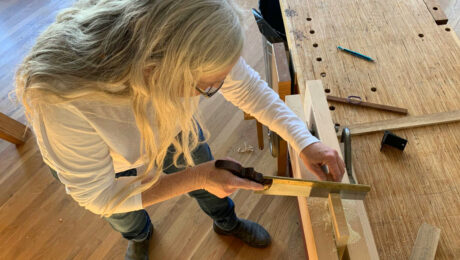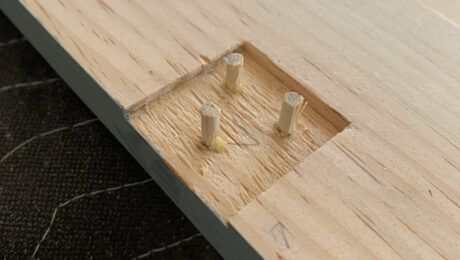I got on-the-job-training to be a teacher long before I picked up a dovetail saw. I was a graduate student in English literature, which in my program meant I was required to teach first-year writing (what we called “freshman comp” at the time). It was in large part a thankless job. Almost every undergraduate in the university had to take at least two quarters of composition, and I’d wager that in any given class, 80% of those students resented having to. (The 20% made it worthwhile, though.) I did my best to make classes fun, but “Grammar Jeopardy!” is a hard sell.
I was also lucky enough to later on teach some 200-level classes in literature (including in my own area of study, early modern drama). Those were elective courses, so at least the students had chosen to be there. My favorite moments – and you could see it on student faces – were when Shakespeare and his contemporaries began to make sense to them, and it suddenly became not a chore, but fun. (Or at least a fun chore.)
Teaching woodworking, however, is the most fun. Ninety-nine percent* of the students I teach are ecstatic to be in a class, and to learn; and there’s that same sudden light in the eyes when a plane behaves perfectly or an operation makes sense to a student for the first time.

While the subject matter is different, my approach to teaching hasn’t changed that much since I first stood in front of the classroom in 1997 (the prep, however, is considerably more physically taxing). So here’s a little bit of what I’ve learned in 25 years of teaching – and take it with a shaker full of salt. Just as there are different ways of learning, there are different ways of teaching. This is what works for me.
Take things slowly – small bites.
Too much information at once is as bad as no information. Example: for dovetail layout, the first thing we do is arrange the wood “properly” – that is, if possible put the inside of the tree out (heart-side out), and make marriage marks. I show this, then send students back to the bench to do it. I always have people who want to race ahead to what’s next. Some of them are new, and simply overeager. They often, on the rush to move forward, forget the task right in front of them: that which must be done properly for the next step to succeed. Or, there’s a student or two who already knows what to do, and doesn’t want to wait around for others to catch up. But we don’t move on to marking baselines until everyone has the marriage marks established. It sounds kinda boring – especially for the early steps. I always remind myself that it’s only boring to those who’ve already done it a hundred times.

When I have students who are significantly more experienced than the rest of the class, I give them extra work (if they want it; it’s a reward – not punishment!) to slow them down, so they don’t get too far ahead. Example: In a joinery class where most people were picking up saws and chisels for the first time, I had one guy who was a longtime hand-tool woodworker. He came to keep a friend company. So while everyone else was cutting through-dovetails, I had him cut his first hounds-tooth joints. (And darned if they weren’t excellent.)
Repeat yourself.
Say the same thing at least a few times in front of everyone while showing an operation, then walk around as students are working and say it again to each of them as necessary. Some things – laying out dovetails with dividers, for example – can be awfully confusing until a person has done it themselves a few times.
Don’t do the work for them.
It can be tempting when someone is struggling to pick up a plane or saw or chisel and help. Don’t do it … unless you see the situation is about to become altogether unsalvageable. And still don’t do it without asking. That said, if someone is struggling with a tool, say a smooth plane, I will hand them my no. 4, then check their plane setup. Often, struggle is due to a fixable problem (like not buying a new smoothing plane from Harbor Freight).

(Almost) always warm up before a demo.
I don’t warm up before talking about marriage marks – but if I’m going to pick up my dovetail saw, you can be sure I’ve already made a dozen cuts just to loosen up – and if possible, gone through the entire operation if it’s a challenging one. Going through an operation always reminds me of something I would have missed had I gone at it cold in front of an audience.

Never do demos using student tools.
Unless you set it up yourself.
Don’t give false praise.
False praise will simply reinforce a bad habit or poor outcome. If you say “good job,” you have to mean it. But you can almost always find something specific in a student’s work – no matter how small – to praise. (Then help them improve at the not-good stuff.)
Watch out for frustration.
More than once, I’ve had a student throw down tools and storm out – and that in turn distracts everyone else. Try to recognize a frustrated student before that happens, then get them to take a walk around the block, or watch a kitten video. A moment of calm and resetting before diving back in.
Never turn your back on a chisel.
If an accident is going to happen in a hand-tool class, it will likely be with a chisel. I fear teaching in rooms where I can’t see everyone at the same time. I need to be able to see to confiscate all chisels pointed at the user’s body. (And I suppose at other people’s bodies…but that hasn’t happened, thank goodness!)

Make it fun.
Most people in a woodworking class for amateurs are there because they think woodworking is or might be fun. Reinforce that in whatever way makes sense for you. For me, that’s bourbon after class, and perhaps a class visit to the local cat cafe.

* That 1% who didn’t want to be there? I had a father-son pair in a class who showed up with the worst imaginable tools and the worst imaginable attitudes. I think their family therapist put them up to it.
 |
Sawing homework |
 |
‘Work slower; it’s faster’ |
 |
Skills class or project class? |








